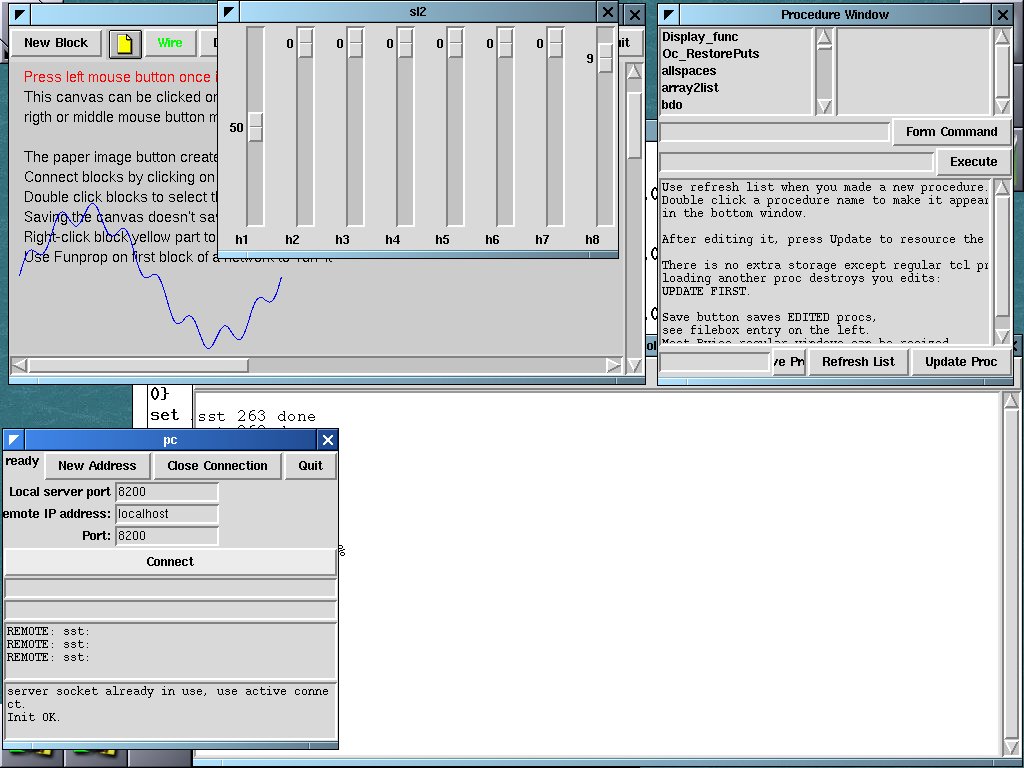Theo Verelst Additive Synthesis Program
Updated Nov 14 2004
I've made a number of audio programs, like this years ago, of
which the most advanced to
time is the String Simulator, but
here is a start of a socket/text
controlled, PA sound lib (v
181) interfaced (OSS under Linux, and also Windows
works) additive synthesis
samples-based sound program, intended as
learning and experimentation tool, and a core to build more sound
programs on.

Screen shot of the
prototype program under Linux RedHat 9, windowmaker, linked with Tcl/Tk
based BWise.
The sound program, which is organized as a simple command line
execution based server, is written in C, and contains a additive
synthesis core based on in main memory sound sample memory.
Interfacing with the core sound program is done with text commands
which control the virtual sound generators, those commands are in this
prototype passed to the sound server by a tcl/tk program sending text
messages over a socket.
I've made two Tcl/Tk programs relevant
to this setup, called Bwise and
Pcom, included in below
distribution.
The idea currently is to have a number of sliders which each control a
harmonic component in the sound. When a slider control is released, a
new waveform will be computed live (causing artifacts in the live
sound, possibly) which is then used as the sample to output to the
sound card.
Readable commands are sent to the soundtest program live, to interact
with it. From the Tcl/Tk (bwise) console window, where commands can be
typed, the tcl procedure 'pcsend', which takes one argument, is used to
send the soundtest program a text command, like:
pcsend "genvol 0 100"
will set the generator volume of oscilator 0 to 100.
Possible commands at the moment are:
genstate <oscilator #> <state>
generator state, 1 is on 0 is off.
genfreq <osc #> <freq>
set generator frequency, in milliherz, so 440Hz would be 440000 .
genvol <gen #> <volume>
set generator volume, IIRC 1000 is maximum.
makeadditivetable <sample table #> <freq 0> <ampl 0> <freq 1> <ampl 1> ... <freq 7> <ampl 7>
make a sample table based on 8 harmonic components, which should be
integers.
exit
quits the sound server program.
gentable
gentsst
I'll add more explanation here, for the moment, check the sources for
arguments and example scripts.
Download
and Installation issues
First, you'll need to have OSS compatible sound on your linux system,
which I think is standard on RedHat9 which I used. On windows, you'd
have to have a soundcard and normal support for it, which will usually
be the case.
For linux, the abovementioned PA sound lib has to be
installed first, see the website, compilation shouldn't be a problem on
linux or cygwin on windows though
possibly not trivial when you're not used to that. There are examples
to try out your soundcard and the library access routines to your
systems sound resources, mind that you can set the latency (the time it
takes for sound to get from the input to the ouput for instance when
you use the 'wire' feedthrough example program) by from a command shell
typing:
export PA_MIN_LATENCY_MSEC=50
which sets the number of milliseconds, so in this case 1/20th of a
second. The lowest latency varies per system, OS, soundcard and
application, probably 50 will work for most modern systems, I could go
to 10 on redhat.
The windows sources include the relevant palib soure files so that it
should be possible to simply make
under cygwin.
I've prepared the following zip files:
soundtest1a.zip 54 kilo bytes sources and RH9 executable , winzip
soundtest1a_win.xip 61 kB sources and .exe (requires cygwin or recent cygwin.dll) , winzip
There are two programs involved in making sounds, the soundtest(.exe)
and a tcl interpreter, which connect over a stream. It takes a little
while to start up the soundtest program first, and then the user
interface and let the connection be established. I the connection
doesn't automatically get established, try pushing the 'connect' button
in pcom. As soon as the connection is made, soundtest should start to
make a sound. which you can then change by the sliders.
On windows, start wish with 'startup.tcl' from the cygwin command like,
in my case for instance:
/cygdrive/c/Tcl/bin/wish startup.tcl
simply
wish startup.tcl
probably works, too, using cygwins' Tcl.
On Linux (/Unix) there is a simple shell script to do the same:
./start.sh
that will do the above, assumingyou have Tcl/Tk installed.
Note that the drawbars work like on an orgran: lower is louder, and
that the result can easily clip.
